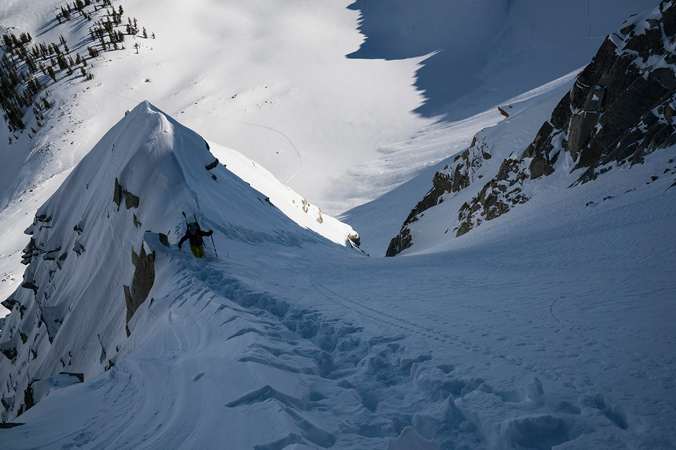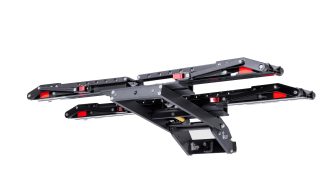Caroline Gleich captures The Chuting Gallery’s most recent story—and for good reason. In April 2017, Gleich, 31, became the first women to ski the book’s 90 lines, finishing the project with a descent of Ciochetti’s Ribbon, which traverses across Alta’s Devil’s Castle Buttress over hundreds of feet of exposure. Gleich told her Chuting Gallery story through the recent film Follow Through, which documents the ups and downs of ski mountaineering in the Wasatch, and Andrew McLean credits the film and her story for the recent spike in book sales. —Louise Lintilhac

Caroline Gleich breathes a sigh of satisfaction upon completing her mission. [Photo] Adam Clark
First Impressions
I moved to Utah when I was 16, and The Chuting Gallery was sitting on the coffee table at one of my friend’s houses—that was my first time seeing it. Initially, I thought it was crazy, but I also thought it was pretty cool, especially because I’d driven past so many of those lines heading up the Cottonwood Canyons as a kid. When you’re little, you’re craning your neck out the window to see all the lines and the mountains, so it was neat to have names for them and to have the context for them, as well.
Favorite Route
My favorite was probably Lone Peak, because it’s challenging to get to, challenging to ski, and there’s a lot of vertical relief. It’s deep in the wilderness, but the trailhead is right at the city doorstep. You start in the middle of the suburbs with the bright city lights below, and then you watch the light pollution fade as you lose sight of the city. You feel so remote. Then you pop out at the top, and you get to see the city again; it’s really one of the best views of the Wasatch. And the line itself is super steep and exposed, and it has all the elements of a serious line.

Caroline Gleich boots Hogum Fork’s Snapdragon, one of The Chuting Gallery’s more challenging lines to find. [Photo] Adam Clark
Steep Legacy
There is a certain timeless appeal to a ski-mountaineering guidebook. It’s partially the way the CG is written and partially because McLean didn’t include a lot of information about how to access the lines. He wrote it in a cryptic and vague manner, and I love that about the book. It captures the heart and spirit of alpinism where there isn’t a detailed printout or a good trail to get through the bushwhacking to get to the line. You have to go and figure it out on your own.
Chuting Lessons
The book taught me a bazillion things. Part of it was the technical skills that I wanted to learn, and the book offered me a framework for learning those things. I’m not just going to use those skills for CG lines; I’m going to use them in Alaska, Chamonix, wherever. Being efficient with ropes and anchors is important as a ski mountaineer, no matter what mountain or range you’re in. It also taught me how to be a leader. Early on, when I asked guys if I could join on their CG missions, they wouldn’t let me come, so I had to learn how to lead my own group. I think that’s definitely a skill that helps teach self-sufficiency and preparedness for being out in winter conditions.
Future Lines
I think the CG is a really cool piece of ski culture and history from the golden age of ski-mountaineering in the ’90s, and I’d like to see a resurgence of that golden era because there’s something so innate about climbing up a mountain to ski down. I want to see more people get into projects like this.









Related posts: